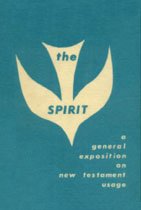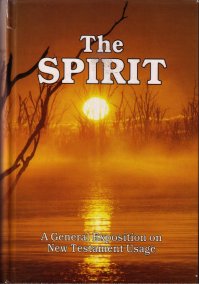

The Spirit
A General Exposition on New Testament Usage
314 pages
Brother Aleck Crawford's notes on the Holy Spirit were first published in 1974 in California. His
latest book is a reorganized and vastly expanded version of those notes. Those who are familiar with Brother Crawford's
earlier offering will know that his views on the important doctrine are, as he claims in the preface to his new book,
"both...Biblical and traditional"; and to that extent this new contribution to Christadelphian literature ought to find
a ready welcome amongst us.
The doctrine of the Holy Spirit has been much discussed in our midst in recent years, and to the
knowledge of the reviewer it has been the subject of at least six separate publications, as well as of lengthy series in
a number of our magazines. Brother Crawford's book has the great advantage of drawing on these documents, and the result
is a very valuable work of reference. The bibliography and footnotes in themselves are good guides to both major and
minor sources of the brotherhood's expressed views on the doctrine, and they show how widely the author has researched
the materials of his book. The index, too, will prove extremely useful to readers wanting quick access to information
about particular passages of Scripture. The author recognises that he has chosen "a difficult and complex subject" to
write about but he has certainly come nearer than anyone so far to providing a complete survey of Christadelphian
interpretation of the New Testament passages at the centre of the unfortunate controversies about the operation of God's
Holy Spirit.
The author is to be commended that in this his second book on the Spirit he has done all reasonably
in his power to avoid 'personalities' in discussing the views of those who, particularly in recent years, have diverged
from the traditional doctrinal emphasis. In his advance publicity notice, Brother Crawford states that the book "has as
its aim the positive exposition of the subject," and he concludes his preface with the hope that his notes may "help to
develop the Spirit of Christ in us that we may become Spirit beings in that day soon to dawn." These are sentiments that
all will echo. And even those who may not agree with all that Brother Crawford writes in this book will admit that the
author's approach is circumspect and thorough, as befits such important subject-matter.

Yet the author is not tender towards what he considers to be wrong ideas, some of which, he claims, "threaten the very survival of the Truth in some parts of the world." Such a comment seems extreme, but it comes from a widely-travelled brother with experience of ecclesial life on at least two continents, and it must be given serious consideration, particularly since the book seeks to give substance to the claim. The section headed "Plato's influence" is an example of this. The desire for direct, personal, mystical guidance, so evident in the evangelical movement in recent years, and associated by that movement with the Holy Spirit, is showing up increasingly within our own community, and Brother Crawford points out, in very informative, tabulated fashion, how this view owes more to the pagan philosophy of Plato than it does to the teaching of the Word of God. Similarly, he traces the evangelical notions of "grace" and "faith," and the non-corporeality of God, back to their Greek source. It is in sections like this, where the writer examines the false doctrines linked with an incorrect understanding of the work of the Spirit, that he makes the reader realise how easily any deviation from the Truth can lead to massive error.
The book has six sections with the following titles:
In the Introduction, the author explains that he has chosen to concentrate on the New Testament usage of "Spirit" because "the subject is largely self-explanatory in the Old Testament, and the current discussion surrounds the New Testament usage of the word." But having said that, he makes it clear that he does not by any means neglect the teaching of the Old Testament: "The Old Testament must be the basis of interpretation for the New." And he adds this telling remark about the 'New Testament Christianity' of so many of our contemporaries: "They come to the New Testament with an evangelical bias, and impose such thinking upon the text where it does not exist." And he pens a guiding rule for every doctrinal approach to the Word of God: "Any interpretation which fails to harmonize all the testimonies of the Holy Scripture must be rejected," This section of the book is taken up with preparing the ground, laying down the author's method of approach, characterising the various views which exist, and outlining his own 'traditional' reaction to them. His reasoning is methodical and well-documented (especially with Scripture references, most of them fully quoted).
His Guidelines to the understanding of Spirit passages in particular is a valuable compilation worthy of the widest possible circulation: the problems of figures of speech, of New Testament idiom, and of translations, are spotlighted, and the all-important question of context is rightly stressed. The section is rounded off with a couple of pages on The Purpose Of The Holy Spirit Gifts which is as clear and concise an explanation of the work of the Spirit in the first century as this reviewer has ever come across.
General subjects is a series of special studies on topics centrally related to the doctrine of the Holy Spirit. "Baptism of Spirit", "being born again," and "Providence and angels"--are some of the themes of this section. The few pages under the headings "God is corporeal" and "Did not cause righteousness" remind us of the ramifications of a correct understanding of the Holy Spirit in other areas of doctrine such as the nature of God, and the process of personal salvation. "Divine assistance," "Guidance and prayer," and "Sanctification" are all of practical help in daily spiritual life, and substantiate the author's claim to a positive approach.
It is the third (and largest) section of the book, however which makes this such a valuable work. It is called Exposition of verses containing spirit. A quick count reveals that at least 150 separate New Testament verses are looked at in detail. This perhaps gives some idea of the scope of the book. The following example is typical, and many readers will recognize that the format is similar to Brother Ron Abel's excellent "Wrested Scriptures".
1 Thessalonians 1:5-6 "For our gospel came not unto you in word only, but also in power, and in the Holy Spirit, and in much assurance... and ye became followers of us, and of the Lord, having received the word in much affliction, with joy of the Holy Spirit."Problem: It is claimed by some that:
A. the gospel is: (l) the word and (2) the Holy Spirit
B. a person who accepts the gospel receives (directly from God) joy which is one of the "fruits of the Spirit" (Gal.5:22).
Solution:
A. (l) The verse is describing how the gospel came to the Thessalonians. Paul is not describing what the gospel is. This is an important point and eliminates the problem A. above.
(2) Paul's letter to the Corinthians is clearer:
"My speech and my preaching was not with enticing words of man's wisdom, but in demonstration of the Spirit and of power." (l Cor.2:4).
Paul spoke and he demonstrated that he had the Spirit to prove that he was speaking the Word of God.(3) The gospel came in: "word" - what Paul spoke. "power" - the regenerating influence these words had on them. "Holy Spirit" - by means of miracles the Apostles were able to demonstrate that the words they spoke were from God. "assurance" - the confidence the missionaries manifested in their message.
B. (l) "The fruit of the Spirit is love, joy, peace, longsuffering, gentleness, goodness, faith...) Gal.5:22)", but these are not received directly from God in the form of the Spirit. They are the product of a person who "walks in the Spirit" and are the opposite of the works of the flesh. A person walks in the Spirit by obeying the word of God, thereby conforming his character to that of the Creator.
(2) The RSV and the NASB margin translate the phrase "with joy inspired by the Holy Spirit". The idea here is that the Holy Spirit - indirectly through the gospel - caused the joy. It was the gospel which caused the Thessalonians joy and that gospel was revealed to the Apostles and Prophets by the Spirit. (By a common figure Metonymy where the cause is put for the result.)
Readers already familiar with Brother Abel's book will know how helpful this kind of point-by-point approach can be.
The remaining sections of the book are likely to be of interest more for the student that the general reader looking for right interpretations of difficult verses. The longest of these sections is on The Spirit gifts; and for its clear analysis of the first-century ecclesial experience of the Holy Spirit at work, this section can be strongly recommended. It is extended in the shorter section, Inter-ecclesial offices, which has many interesting sidelights on the organisation of the early ecclesias during the years of the open manifestations of the Spirit. The final section, Word studies, forms a useful adjunct to the book, for the Scriptural meanings of the words looked at ('gift', 'holy', 'Paraclete', spirit' and 'word') are often misunderstood, and such misunderstanding is frequently the starting-point of many of the doctrinal errors reviewed by Brother Crawford.
The book does of course have its weaknesses. It is written largely in note form, and though this can be advantageous for certain purposes, it tends to make continuous reading difficult. The author is, however, aware of this, and gives the reader this advice on the Contents page: "The book is designed as a reference textbook. It is not anticipated that many will read it from cover to cover, but anyone who does so will be well rewarded. It is highly recommended that Sections A & B be read from start to finish." The English style could perhaps have been improved in places; and it is not always clear where the author is quoting from other writers, or where he is using his own words. But bearing in mind that the book is basically an edited compilation, or rather a distillation, of the views of others, it must be said that the author has done well to get so much into a single book and to present it in such a lucid way. Certainly, none of the weaknesses of the book detracts from its value as a work of reference. Its appearance ought to do much good in tying down discussion of the doctrine of the Holy Spirit to a correct understanding of Scripture. And in giving a comprehensive review of what the standard Christadelphian teaching on the subject has been until now, it is, to say the least, a timely reminder of what we as a body are supposed to believe.
[A review done in 1976 on the first printing (blue cover) of the second edition. The second printing of the second edition was done in 1990 and appears at the top of the page.]
2001 Net Edition in PDF format
2001 Net Edition in Word format Part 1
2001 Net Edition in Word format Part 2
|
||||